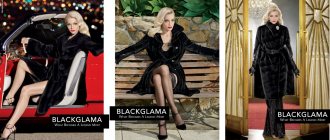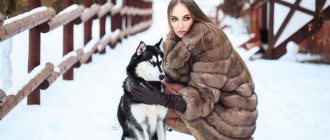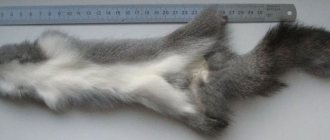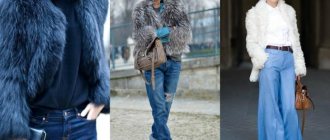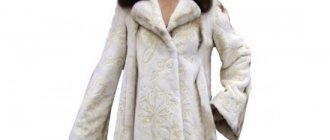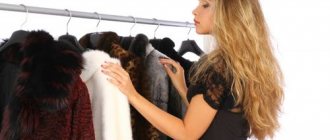Blue mink is a classic of the fur market. This fur has been one of the most elegant and sophisticated for centuries. The owner of such a fur coat automatically looks exclusive and stands out for her status, so many women dream of purchasing it. Blue mink is one of the most popular, but in order to buy a good fur coat from this fur, you need to know some features.
Choosing a blue mink coat
Mink is different from mink
First of all, when choosing a fur coat, you should pay attention to the fur. If it doesn’t seem thick enough to you, it’s worth asking what time of year the skin was obtained. The fact is that the winter animal is much more pubescent and has more luxuriant fur, while the summer animal’s skin is more scanty and does not shine with luxury.
Everything in a fur coat should be perfect - the appearance of the fur, its color, and the “ins and outs.” Therefore, when choosing a mink fur coat, you should carefully examine not only the fur, but also the seams of the product. A high-quality fur coat will have all seams done neatly, will not “creep”, and there will be no creases on the product. Feel free to pluck and shake the fur coat - if the fur is of really high quality, it will not fall off too actively - a couple of hairs may remain in your hands, but no more.
Mink fur can also be plucked and shorn. Plucked fur is a skin that has been processed in such a way that, with the help of special devices, long and hard fibers are removed, leaving only the soft undercoat. After this treatment, the skin becomes especially soft and fluffy, but the wear period is significantly reduced, so often, in order to protect it from abrasion, a plucked fur coat is supplemented with unplucked mink on the collar and sleeves.
Sheared mink looks quite interesting, but it is important to remember about such processing that most often the fur is processed in such a way as to hide defects in the skin, and sheared fur does not retain body heat well.
Let's dispel the myth about dyed fur together
My name is Tatyana and this is my first publication, please don’t judge too harshly :), I know how to sew, but I’m just learning to write on a blog :).
Since I have been engaged in individual tailoring of clothes and accessories made of fur and leather for more than 35 years, I communicate with many people.
I noticed this feature: many people have very little reliable information about fur.
Most of the “knowledge” is taken from the Internet, which is teeming with reasoning, expert assessments and master classes of laymen; look, you don’t know whether to cry or laugh.
Since there is now such an abundance of beautiful fur, not only natural, but also colored, I, as a craftsman, really want to decorate and delight our beautiful women with bright, luxurious products. It's always a pleasure to create beauty!
Many people want to look chic, be beautiful, fashionable, modern. But many, not all of course, are distrustful of colored, dyed fur.
Let's look at some misconceptions that give rise to people's persistent mistrust of dyed fur:
- he will dye and stain clothes;
— paint deteriorates the fur;
- The color does not last long.
We owe these myths to the time when handicrafts flourished. Professional coloring then required complex equipment and expensive reagents: chromium, iron and copper sulfate, etc. Handicraftsmen did not have such opportunities, so they dyed the skins somehow and with what they had. Few people were interested in how and how long such fur would be worn.
The introduction of aniline dyes into practice significantly simplified production, increased color strength and the range of shades obtained. In modern production, fur is dyed so reliably that the color lasts longer than you wear the product itself. Naturally, professionally dyed fur will never stain your clothes.
Note to the owner: both dyed and natural fur fade from sunlight. Moreover, white, beige, gray, blue and some other light colors suffer more than others: yellowness appears more noticeably on them.
In conclusion, I will add that now they paint not only reliably, but also very beautifully: in almost any color, in gradients, with prints.
I won’t overload you with pictures, besides mine there are a lot of them on the Internet, and you can also admire the fur “live” by visiting a state fur farm or fur companies specializing in the sale and sale of auction furs.
To summarize: if the fur has undergone high-quality dressing and painting, you should not have any concerns about it. Dyed fur is wonderful!
Thank you so much for reading! If you liked my ode to colored fur, let me know, I will be glad to see your likes, support, comments, and ratings. And even if I didn’t like it, I’ll be interested too).
If you have something to say, write, I’m always interested in learning something new, seeing a different point of view.
With respect to everyone present, your Tatyana.
You have to pay for the color
Different colors of mink also cost differently. The simplest option is light brown or walnut mink. A little higher in the price category is dark brown mink, and it is surpassed by all shades of red - from honey to amber. Black, grey, beige and blue mink are even more valuable.
I would like to talk about the latter separately. Just a few years ago, due to its popularity, blue mink was worth very impressive money, but now the passion for blue fur has faded, and this type of mink has become more affordable. A smoky brown mink with a beige undercoat and dark, coarse long hairs will cost even more. Snow-white mink is also comparable in price, as is another version of white fur - white skin with a slight splash of long gray hairs.
The so-called “black diamond” has remained unsurpassed in price for a long time. This color, even deeper than black, delights with its rich, almost violet hue. However, no matter how expensive and luxurious the “black diamond” is, it is still not the dream of all customers - some people like dyed mink in extreme colors.
These are the luxurious colors that natural, undyed mink can have
Most often, customers believe that the dyed mink was white before this process, and therefore can cost a significant amount of money. However, this is not always the case - modern dyeing technologies make it possible to successfully introduce color into fur of a light walnut shade, as the cheapest option. However, if you want to buy a fur coat made of bright pink or blue fur, then you need to take into account that it was originally white, that is, very expensive.
Dyed mink - fresh and rich colors
“Age-related” problems with fur coats
A fur coat is a thing that is bought for many years. And even if the product loses its former appearance over time - it fades under the influence of the sun or loses its former shine - this does not mean that it is time to say goodbye to the thing. You can dye a fur coat and thereby give it a new life.
What problems do fur coats experience during the “aging” process?
- First of all, this is yellowing . Whether light influences this process - artificial or natural - is not important. That is why it is recommended to store a fur coat in a case - otherwise, when opening the closet, light will fall on the fur coat, causing color changes (and often only on part of the product, which makes it much less presentable). It is important to understand that yellowing does not affect different types of fur equally. So for warm shades we can talk about enhancing the color, but white or blue fur coats lose their attractiveness to a greater extent due to yellowing.
- Another problem with fur coats is the aging of the skin itself. This process cannot be stopped, although it does not proceed in the same way for fur coats of different quality. The higher the quality of fur dressing and dyeing of the product, as well as the careful storage, the longer it will retain its strength. But the process practically does not depend on the intensity of operation.
There are two degrees of aging of a fur coat. The first (usually 5-10 years) is characterized by the fact that the fur coat is almost unsuitable for any work associated with humidity and wetness, and the second (above 10 years) is characterized by the dilapidation of the leather base. Often at this moment the fur coat can no longer withstand simple mechanical loads.
How to choose the right blue mink coat
The first thing you should do when buying a fur coat is to check its quality. Dressing the skin: the flesh should be soft, light, the fur should also be soft, silky, without bald spots, easily wrinkled and straightened in the hands. It is better to choose a blue mink model from several products of different color and quality, having a good look at them in the light.
Good fur should have a natural azure shade, without yellowness. It is no secret that blue mink turns yellow over time, and if a fur coat has been hanging in a store for several years, this becomes noticeable. This is especially true for products from China. Against the background of coffee flowers, the yellowness will not be so noticeable, so examine the blue mink separately and in the light. Blue tinting allows you to preserve the natural color of the fur longer.
Fur dyeing: process, pros and cons
For dyeing fur, only natural dyes of organic origin are used. They can be:
- animals – such as sepia;
- plant - for example, logwood, mahogany or fernambuco, ink nuts, as well as betel, quebracho and many others.
Each type and grade of fur requires special preparation for dyeing. So, for example, it is more difficult to paint a long, hard pile than the undercoat. In addition, it is necessary to take into account the “age” of the product. After all, as mentioned above, a fur coat older than 5-10 years can survive painting with difficulty.
Theoretically, fur dyeing can be done by any dry cleaner that has the appropriate chemicals and an aqua-cleaning machine, but the result of their work may not live up to expectations, because soft and light fur coats (which are the majority now) have great difficulty surviving this procedure, which requires high temperatures. That is why it is much better to go not to a dry cleaner, but to a professional fur studio in Chelyabinsk, where I will not only help you with dyeing, but will also professionally assess the riskiness of the procedure specifically for your fur coat. This is where the work is done efficiently and quickly, and the result exceeds all customer expectations.
The fur from which this fur coat is made is dyed rich blue in our fur studio
What you need to know when dyeing fur:
- If the product, due to the age and quality of the fur, does not withstand the temperature, then it will be irretrievably lost (the chance of an unfavorable outcome can be estimated as 50/50, but much depends on the assessment of the specialist of the fur studio) - that is why the product is checked for rupture of the inner layer before dyeing (bursting the mezra excludes the possibility of coloring).
- After dyeing, a fur coat is guaranteed to shrink and change parameters, that is, the product will need to be recut (perhaps a reasonable option would be to shorten the fur coat), and it is also necessary that the product initially be quite loose (losses can amount to 10-20 cm in width and length).
- The core of the product will shrink and become stiffer, so even the lightest fur coat after dyeing becomes denser and less elastic.
- As a result, you will get a completely different thing - more stylish and modern.
- And most importantly, do not try to perform the dyeing procedure at home. First of all, you need to take into account that all chemicals and paints are very toxic and, if used incorrectly, can harm your health, and in addition, optimal, even coloring, which will not lead to loss of fur coat, may not be possible for everyone.
Our work on altering a fur coat
Another job of remaking a fur coat
Still have questions? Get a consultation from a specialist from Atelier Ural Request a call
Is it worth buying a dyed fur coat?
Do you prefer fur coats in bright, rich colors, but are you afraid that dyed fur will last much less than natural fur? Or maybe, on the contrary, you love exclusively natural shades, because you think that such products are of higher quality? In fact, buying colored or natural fur is a matter of taste. However, here it is important to distinguish for what purpose the fur was dyed.
For what reasons is fur dyed?
- To hide defects.
If the skin was processed incorrectly, dyeing will lead to an even greater deterioration in its quality. The hair will hold onto the core weaker, become more brittle and quickly lose its shine. The flesh (the back side of the skin) will become less elastic and may become very thin, which will lead to its ruptures. - To counterfeit cheap fur with more expensive and valuable ones.
This is done by unscrupulous manufacturers who pursue increasing profits by any means necessary. Most often, marmot or rabbit fur is faked as mink. Nutria is “disguised” as a beaver (the latter has thicker down, a longer spine, and fluffier fur). They pass off a rabbit as an expensive chinchilla (chinchilla fur is thick and looks like fluff, since several hairs grow from one bulb at once; chinchilla skins are also much smaller than rabbit skins, the size of one skin is no larger than the palm of your hand). Instead of a silver fox, you can easily buy a bluefrost (the latter's hair is two-colored, while the silver fox's is gray at the base, white in the middle and black at the tips). - To give the fur integrity, richness, and uniform shade.
To do this, the skins are tinted, which enhances the natural shade and makes the product more attractive. - To implement various design solutions
. It is painted pink, blue, green and other colors that are not found in nature. Such manipulations with fur allow you to create incredibly beautiful, bright products. For example, in patchwork style. - To imitate the color of exotic animals, such as a leopard.
It is clear that not everyone has the financial opportunity to purchase a real fur coat made of lynx or leopard, but they really want to stand out. For this reason, screen painting has become so popular.
How to determine if fur is dyed?
If you fundamentally choose products of natural color, you definitely need to know how to determine whether the skin has been dyed. It can be difficult to distinguish dyed fur - modern dyeing methods negate all recognition methods. However, you can try to do this using the following recommendations:
- The back side of the skin (the inner side) should have a white or matte cream tint. Brown, black or red color will indicate that the skin has been dyed or is old (it will also be hard and rustling).
- If the lining is tightly sewn and there is no way to assess the color of the inner layer, blow on the fur. An undyed fur coat will have a light skin tone, but a dyed one will have a light color, depending on the color of the paint (for example, black).
- Run a damp cloth over the fur - if it is stained, you have a dyed fur coat.
- If the color is uniform, of the same intensity throughout the entire product, there is no transition from the down to the awn, there are no defective fibers (for example, among the dark ones there is one light one), it is highly likely that the fur was dyed or tinted.
Even if you prefer exclusively natural shades, but the chosen fur coat has obviously been dyed, don’t worry! With proper dyeing, the result is fur that has all the advantages of natural fur, but which at the same time looks very elegant and attractive! And to buy a product whose dyeing quality you have no doubt about, choose fur coats from well-known fur factories in specialized salons. If in any doubt, ask the seller to provide you with quality certificates, which will indicate what kind of fur was used to sew a particular model.
Choose a suitable fur coat in our online store Marketmeha.ru, place an order online or come to any of the Fur Hypermarket retail stores! Our catalog contains products from more than 22 types of fur from famous Russian, Greek and Italian manufacturers. Waiting for you!
